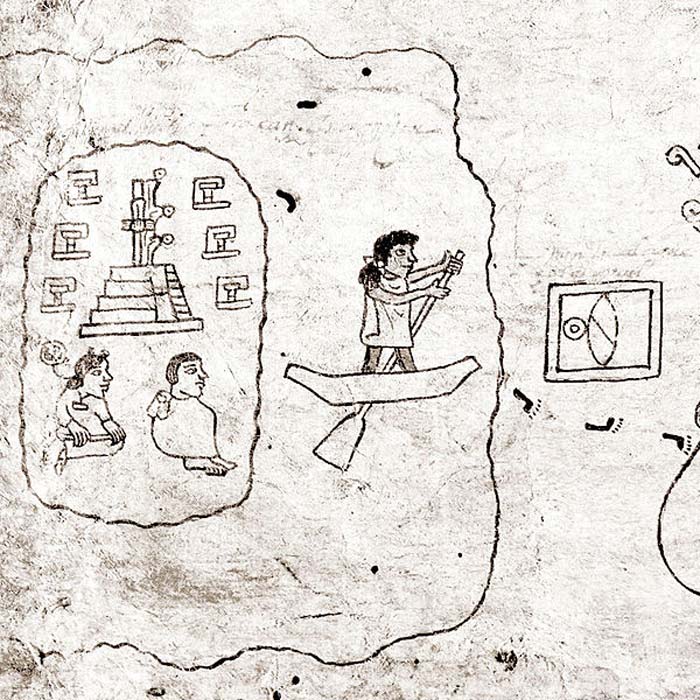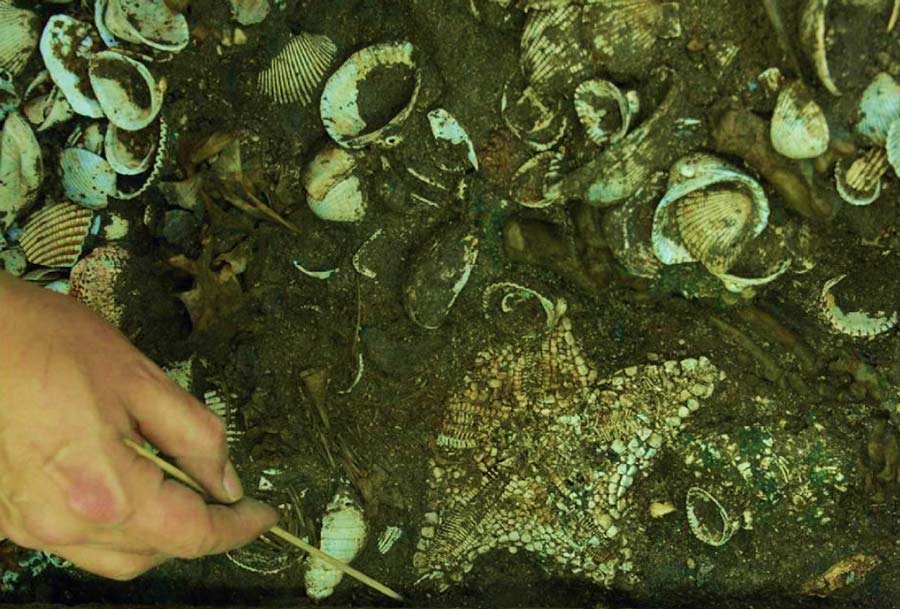Biggest Aztec Starfish Altar Ever, Found in Templo Mayor, Mexico City!
Archaeologists from Mexico’s National Institute of Anthropology and History (INAH) found the largest ever Aztec starfish altar offering site at Templo Mayor, the largest Aztec temple. Templo Mayor was located in the Aztec capital city of Tenochtitlán, in what is now Mexico City. “In total there are 164 starfishes there, which makes it the altar with the largest number of starfishes we’ve found up until now,” said the INAH report.
The Aztec starfish altar, dated to around 1500, was decorated with seashells and starfish. A specific species of starfish known as Nidorella armata, less formally as the chocolate chip sea stars, were used for the purpose. The starfish get their nickname from their mottled orange and black body, that resembles the coloring of jaguars. “This is really interesting because if you think about it, this starfish looks like the skin of a jaguar. It’s orange with dark spots,” Miguel Báez Perez, one of the archaeologists who discovered the altar stated.
Since jaguar bones were also found at the altar within Templo Mayor, archaeologists believe that the starfish altar was dedicated to war, according to a news report on the Inside Edition.
An offering of sea creatures may seem unusual in a capital city located 2250 meters (7381 feet) above sea level, but it was by no means so, according to a report in the Times. In fact, the Aztecs venerated sea creatures, especially starfish, and brought them in the thousands to offer at their Great Temple.

This map of the expansion of the Aztec Empire shows how easy it was to have a giant starfish altar offering site far from the coast as the empire was well establish on sea and land. (Maunus / Public domain)
The Starfish Altar and Aztec Access to the Coast
So how did the Aztecs access a coast that lay nearly 300 kilometers (186 miles) away from the capital city of Tenochtitlán? Not only that, the same altar also contained chunks of coral that came from roughly the same distance away but in the opposite direction, the western end of the Gulf of Mexico, reports Ars Technica.
- Religion of the Aztecs: Keeping the Balance in an Unpredictable and Terrifying World
- Xipe Totec: This Gory God Shows the Unique Way Aztecs Viewed Fertility and Renewal
The answer lies in the conquests of Aztec ruler Ahuizotl who ascended the throne in 1486. He immediately embarked on a project of conquest that stretched the Aztec empire west to the Pacific coast of Mexico and southeast to Guatemala. This meant that starfish from the Pacific and coral from Gulf of Mexico, along with seashells and even pufferfish could be brought to offer to the Aztec gods at the starfish altar and others, likely.

The Mexica people (who are the first Aztecs) depart from “seaside” Aztlán and go inland to the area of present-day Mexico City. From the 16th Century Codex Boturini. Created by an unknown Aztec hand in the 16th century. (Public domain)
The Aztec Empire Starts, Peaks and Falls
The Aztec empire started in around 1325 when the Mexica people migrated from their mythical “Aztlán” homeland to the area around what is now Mexico City. There they saw an eagle sitting perched on a prickly pear (a type of cactus) eating a snake. This was a sign, they were told by their priests, from Huitzilopochtli, their god of sun and war. Thus, they built the incredible city of Tenochtitlán on the site that is now modern Mexico City. So important is this founding myth in Mexica lore that the image of the eagle devouring a snake is part of the Mexican flag!
Under the eighth ruler Ahuizotl, the Aztec empire stretched from coast to coast and was at its peak. Ahuizotl accompanied his expansion drive with a renovation of the capital city including Templo Mayor. Renovation in Aztec terms meant adding a new, bigger layer atop the older one, and a ritual “killing” of the old temple before the new one was consecrated. Ahuitzol’s was the sixth and second last layer of the temple.
Ahuizotl was the last Aztec ruler before the Spanish conquistadors, led by Hernán Cortés, arrived in 1519 and altered the course of Mexican history. Cortés reached Mexico during the rule of Ahuizotl’s nephew, Moctezuma II, who died fighting the Spanish.
His brother who succeeded to the throne died of smallpox, a disease that came with the Spanish. Ahuizotl’s son Cuauhtémoc, who came next, chose to surrender to the Spanish forces in 1521. But Cortés believed that the Aztecs possessed a vast treasure of gold and silver and tortured Cuauhtémoc to reveal its whereabouts. Eventually, in 1525, Cuauhtémoc was executed, thus ending the Aztec ruling line.

Here you can see the seashells and jaguar bones that were also present at the starfish altar of Tenochtitlán. (YouTube screenshot / INAH TV)
Templo Mayor and the Starfish Altar
Huitzilopochtli wasn’t the only god to be housed in the Templo Mayor. Tlaloc the god of rain and farming also had his own shrine built within the compound. Separate staircases led to the shrine of each god, atop the pyramid.
The ruins of Templo Mayor were discovered in the 20th century underneath the Christian cathedral that Cortés had built over it. The seventh and last layer of the temple was virtually destroyed in the construction of the cathedral. It was Ahuizotl’s layer built in around 1487 that was the last well-preserved layer.
- The Lost City of Aztlan – Legendary Homeland of the Aztecs
- Art of an Empire: The Imagination, Creativity and Craftsmanship of the Aztecs
It was in this sixth layer that the starfish altar was recently found. It was placed in a round building called the Cuauhxicalco. Historical records and other finds suggest this is part of the shrine of Huitzilopochtli, and so it is likely that the starfish and other items were offerings to the war god.
The site of Templo Mayor continues to provide the modern descendants of the Aztecs with clues to their civilization that was destroyed by the Spanish. The six layers that predate its destruction by the Spanish are a rich source of cultural artifacts for the Mexican people today.
Top image: The largest Aztec starfish altar was found last year in the biggest temple, Templo Major, in the ancient city of Tenochtitlán (Mexico City) along with jaguar bones and countless seashells. Source: INAH
By Sahir Pandey
References
Hammond, N. 2017. Aztec gods were starfish lovers. Available at: https://www.thetimes.co.uk/article/aztec-gods-were-starfish-lovers-b50fnk5fg
Inside Edition. 2022. Archaeologists Unearth 500-Year-Old Aztec ‘Starfish Altar’ in Mexico Believed to Have Been Dedicated to War. Available at: https://www.insideedition.com/archaeologists-unearth-500-year-old-aztec-starfish-altar-in-mexico-believed-to-have-been-dedicated
SG.News. 2022. Archaeologists discover 500-year-old Aztec starfish altar. Available at: https://sg.news.yahoo.com/archaeologists-discover-500-old-aztec-044502471.html
Smith, K. 2022. Largest Aztec temple was decorated with over 100 starfish. Available at: https://arstechnica.com/science/2022/03/largest-aztec-temple-was-decorated-with-over-100-starfish/



















